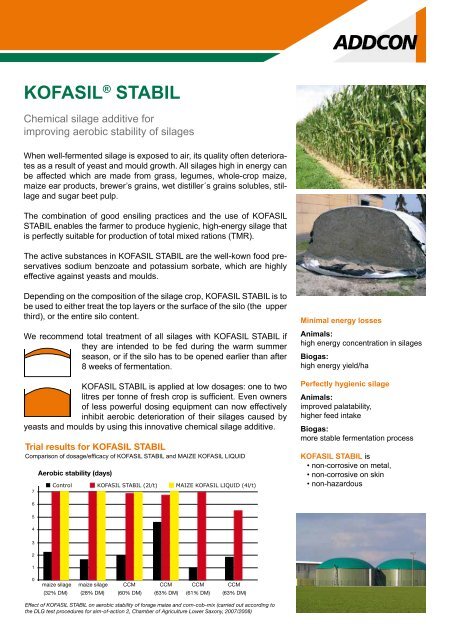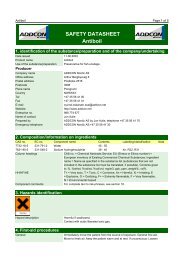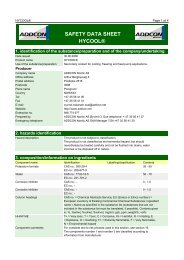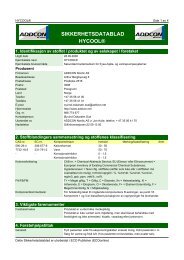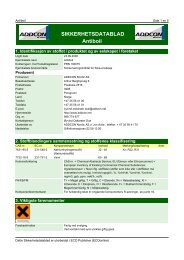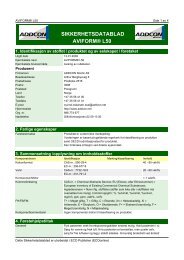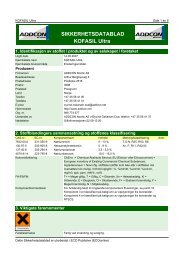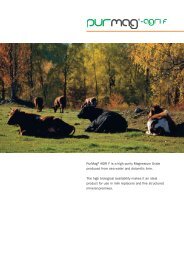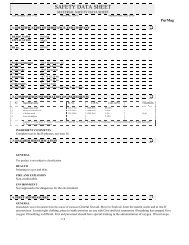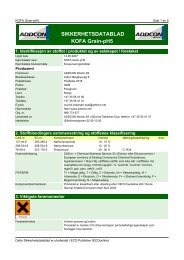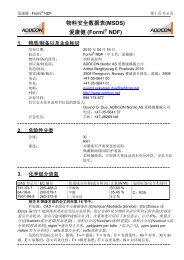You also want an ePaper? Increase the reach of your titles
YUMPU automatically turns print PDFs into web optimized ePapers that Google loves.
KOFASIL ® <strong>STABIL</strong><br />
Chemical silage additive for<br />
improving aerobic stability of silages<br />
When well-fermented silage is exposed to air, its quality often deteriorates<br />
as a result of yeast and mould growth. All silages high in energy can<br />
be affected which are made from grass, legumes, whole-crop maize,<br />
maize ear products, brewer’s grains, wet distiller´s grains solubles, stillage<br />
and sugar beet pulp.<br />
The combination of good ensiling practices and the use of KOFASIL<br />
<strong>STABIL</strong> enables the farmer to produce hygienic, high-energy silage that<br />
is perfectly suitable for production of total mixed rations (TMR).<br />
The active substances in KOFASIL <strong>STABIL</strong> are the well-kown food preservatives<br />
sodium benzoate and potassium sorbate, which are highly<br />
effective against yeasts and moulds.<br />
Depending on the composition of the silage crop, KOFASIL <strong>STABIL</strong> is to<br />
be used to either treat the top layers or the surface of the silo (the upper<br />
third), or the entire silo content.<br />
We recommend total treatment of all silages with KOFASIL <strong>STABIL</strong> if<br />
they are intended to be fed during the warm summer<br />
season, or if the silo has to be opened earlier than after<br />
8 weeks of fermentation.<br />
KOFASIL <strong>STABIL</strong> is applied at low dosages: one to two<br />
litres per tonne of fresh crop is sufficient. Even owners<br />
of less powerful dosing equipment can now effectively<br />
inhibit aerobic deterioration of their silages caused by<br />
yeasts and moulds by using this innovative chemical silage additive.<br />
Trial results for KOFASIL <strong>STABIL</strong><br />
Comparison of dosage/efficacy of KOFASIL <strong>STABIL</strong> and MAIZE KOFASIL LIQUID<br />
7<br />
6<br />
5<br />
4<br />
3<br />
2<br />
1<br />
0<br />
Aerobic stability (days)<br />
Control KOFASIL <strong>STABIL</strong> (2l/t) MAIZE KOFASIL LIQUID (4l/t)<br />
maize silage maize silage CCM CCM CCM CCM<br />
(32% DM) (28% DM) (60% DM) (63% DM) (61% DM) (63% DM)<br />
Effect of KOFASIL <strong>STABIL</strong> on aerobic stability of forage maize and corn-cob-mix (carried out according to<br />
the DLG test procedures for aim-of-action 2, Chamber of Agriculture Lower Saxony, 2007/2008)<br />
Minimal energy losses<br />
Animals:<br />
high energy concentration in silages<br />
Biogas:<br />
high energy yield/ha<br />
Perfectly hygienic silage<br />
Animals:<br />
improved palatability,<br />
higher feed intake<br />
Biogas:<br />
more stable fermentation process<br />
KOFASIL <strong>STABIL</strong> is<br />
• non-corrosive on metal,<br />
• non-corrosive on skin<br />
• non-hazardous
Recommendation for the use of<br />
ADDCON´s range of silage additives<br />
Action against<br />
moulds & yeasts<br />
(all silages)<br />
Alfalfa<br />
Alfalfa / grass<br />
Clover<br />
Clover / grass<br />
Ryegrass<br />
Other grasses<br />
Whole-crop<br />
cereals<br />
Forage maize<br />
Maize products /<br />
moist grains<br />
DM (%)<br />
ADDCON EUROPE GmbH<br />
Kaiserstr. 1a, 53113 Bonn<br />
Germany<br />
Phone: +49.228.91910-0<br />
Fax: +49.228.91910-60<br />
eMail: info@addcon.net<br />
1.0 - 2.0<br />
3 2 1<br />
4 3<br />
0.5 - 2.0<br />
0.5 - 2.0<br />
4<br />
3 2 1<br />
4 3<br />
0.5 - 2.0<br />
0.5 - 2.0<br />
4<br />
3 2 1<br />
4 3 4<br />
3 2<br />
0.5 - 2.0<br />
0.5 - 2.0<br />
1<br />
4 3 4<br />
3 2<br />
0.5 - 2.0<br />
0.5 - 2.0<br />
1<br />
4 3 4<br />
3 2<br />
0.5 - 2.0<br />
0.5 - 2.0<br />
0.5 - 2.0<br />
1<br />
4 3 4<br />
3 2<br />
0.5 - 2.0<br />
0.5 - 2.0<br />
0.5 - 2.0<br />
1<br />
4 3 4<br />
0.5 - 2.0<br />
0.5 - 2.0<br />
5 4 3 4 5<br />
5 4 3<br />
0.5 - 2.0<br />
4 5<br />
< 20 20 30 40 50 60 70 80 > 80<br />
For further informations see: www.addcon.net<br />
KOFASIL ® <strong>STABIL</strong><br />
KOFASIL ® LIQUID<br />
KOFASIL ® BALE / ULTRA<br />
MAIS KOFASIL ® LIQUID<br />
KOFA ® GRAIN -pH 5-<br />
KOFASIL ® LIFE / KOFASIL ® LAC<br />
KOFASIL ® LIFE M / KOFASIL ® S<br />
KOFASIL ® DUO<br />
The recommended application rate<br />
(litre/t) is shown in the bars.<br />
2 3 4 5<br />
2 3 4 5 4<br />
0.5 - 2.0<br />
Dosage:<br />
KOFASIL <strong>STABIL</strong> is applied directly<br />
on the harvester.<br />
As KOFASIL <strong>STABIL</strong> is noncorrosive,<br />
it can be applied<br />
with any suitable dosing equipment.<br />
We recommend the modular<br />
dosing devices manufactured<br />
by our partner company<br />
SILA GmbH, Bitterfeld, which<br />
can be mounted on any standard<br />
harvesting machinery.<br />
See www.silaspray.de<br />
Your KOFASIL <strong>STABIL</strong>-technical adviser:<br />
Technical Data<br />
Composition:<br />
sodium benzoate (E 211),<br />
potassium sorbate (E 202)<br />
Density: 1.13 - 1.15 g / cm3 pH: approx. 8.0 - 9.5<br />
Storage:<br />
Store in a dry, cool (frost-free) place.<br />
Avoid exposure to direct sunlight.<br />
When stored in sealed original containers,<br />
KOFASIL <strong>STABIL</strong> can be<br />
used for 24 months after manufacturing<br />
date without loss of activity.<br />
Classification under animal feed<br />
legislation:<br />
The active substances in KOFASIL<br />
<strong>STABIL</strong> have been notified in the<br />
EU according to Regulation (EC) No<br />
1831/2003, category: technological<br />
additives, functional groups: silage<br />
additives and preservatives<br />
Packaging units:<br />
Canister (26 litres)<br />
Drum (215 litres)<br />
Container (1,000 litres)


